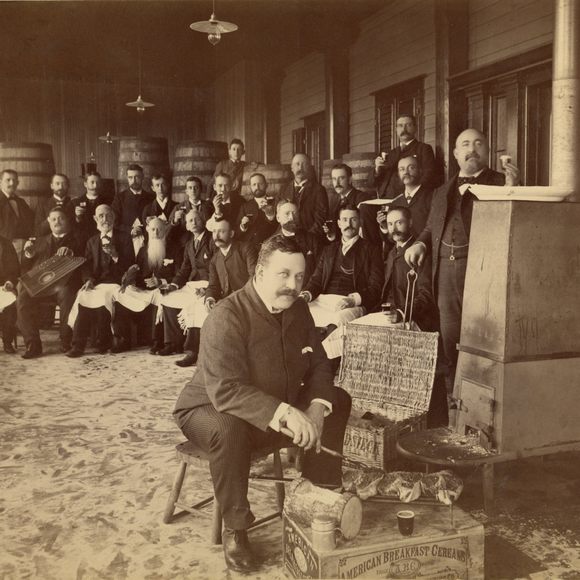The beefsteak banquet has been a tradition in the greater New York area since the Victorian era, but there’s nothing buttoned-up about these cutlery-free beef bacchanals.
For a fixed price, eaters are rewarded with unlimited grilled steak atop slices of white or French bread. Diners don’t actually eat much bread, which is mostly a conveyance device for beef, since going without plates and utensils is the point of the banquet. Instead, the bread stacks up along the tabletops as everyone eats their meat with a healthy coating of butter and Worcestershire sauce. Beer flows freely, and at a New Jersey beefsteak, french fries are also plentiful. Attendees receive white aprons to deter steak splatter—but no napkins—and eat to the tune of live music, which historically was of the German oompah variety.
Beefsteaks got their start in New York as blue-collar fundraisers for political campaigns and causes. The settings were humble, with most beefsteaks being held in community halls, bars, and basements (fondly called “dungeons”). By the 194os, the tradition was entrenched enough to acquire two distinct styles, East Side and West Side. East Side beefsteaks are the standard to this day, with the focus on the beef, bread, and beer. West Side beefsteaks were a bit more refined; one famous venue offered crabmeat appetizers and even provided forks to eat them with. Instead of plain white bread, the steaks were served on hot toast. But both sides celebrated eating with one’s hands and maintained that their style was the most traditional.
The bard of the beefsteak was writer Joseph Mitchell, who in his 1939 New Yorker essay “All You Can Hold For Five Bucks” laid out the history and rules of contemporary gatherings with a misty look back at the feasts of yesteryear.
“[At] a contemporary beefsteak it is unusual for a man to do away with more than three pounds of meat and twenty five glasses of beer,” he laments. He attributes the new decorum to the admittance of women. Early beefsteaks were men-only, and Mitchell speculates that the presence of women put a chilling effect on the gluttony.
The tradition slowly faded away in New York. But it survived without interruption in parts of New Jersey, and there has been a New York revival that seems like a reaction to the rise of artisanal small plates. The appeal of endless beef, it seems, is timeless.
Written By
 Anne Ewbank
Anne Ewbank
Sources
- www.foodandwine.com/fwx/secrets/11-best-tips-gorging-yourself-beefsteak
- books.google.com/books?id=DWzqgi6lcroC&pg=PA5&lpg=PA5&dq=%22all+you+can+hold+for+five+bucks%22&source=bl&ots=_eY0qHUujd&sig=TIZWvz_CFWz8h8PNis3CIfYTDeU&hl=en&sa=X&ved=0ahUKEwj7m6blq8rVAhXMTCYKHfIuCEg4ChDoAQg3MAM#v=onepage&q=%22all%20you%20can%20hold%20for%20five%20bucks%22&f=true
- www.nytimes.com/2011/04/17/nyregion/beefsteak-banquets-undergo-revival-in-new-york.html
- www.nytimes.com/2008/01/30/dining/30beef.html

















